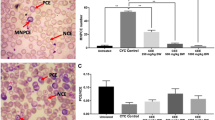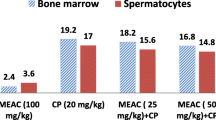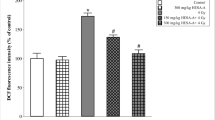Abstract
A major drawback with cancer chemotherapy is its severe toxic effects on non-target tissues. Assessment of natural products for their protective effect against anticancer drugs-induced toxicity is gaining importance in cancer biology. The present study was aimed at assessing the protective effect of hydroethanolic extract of Indian propolis (HEIP) against mitomycin C (MMC)-induced genotoxicity and cytotoxicity. Swiss albino mice were injected with various doses of HEIP (100, 200, 300, 400, 600 and 800 mg/kg b. wt., i.p) 1 h prior to MMC (8 mg/kg, i.p.) injection. The geno- and cyto-toxicities were evaluated in mice by performing bone marrow micronucleus and TUNEL assays. In vitro antioxidant and lipid peroxidation inhibitory assays were carried out to understand the mechanism of the protective effects. The significant increase in the frequency of micronculeated cells (12.51 ± 0.48), apoptotic cells (23.43 ± 1.86) and reduction in P/N ratio (0.69 ± 0.04) compared with control indicated the potential geno- and cytotoxic effects of MMC in bone marrow. Pretreatment with HEIP resulted in the significant recovery of the toxic effects induced by MMC. HEIP at 400 mg/kg b. wt. was found to be the optimum dose imparting the maximum protective effects. The in vitro antioxidant and lipid peroxidation inhibitory assays suggest that the extract possesses substantial free radical scavenging activities. In conclusion, HEIP possesses substantial geno- and cyto-protective properties against MMC, which could be mediated through efficient free radical scavenging and inhibitory effect on lipid peroxidation.


Similar content being viewed by others
References
Abdulrhman M, El Barbary NS, Ahmed AD, Saeid ER (2012) Honey and a mixture of honey, beeswax, and olive oil-propolis extract in treatment of chemotherapy-induced oral mucositis: a randomized controlled pilot study. Pediatr Hematol Oncol 29:285–292
Astani A, Zimmermann S, Hassan E, Reichling J, Sensch KH, Schnitzler P (2013) Antimicrobial activity of propolis special extract GH 2002 against multidrug-resistant clinical isolates. Pharmazie 68:695–701
Benguedouar L, Boussenane HN, Wided K, Alyane M, Rouibah H, Lahouel M (2008) Efficiency of propolis extract against mitochondrial stress induced by antineoplasic agents (doxorubicin and vinblastin) in rats. Ind J Exp Biol 46:112–119
Benkovic V, Knezevic AH, Orsolic N, Basic I, Ramic S, Viculin T, Knezevic F, Kopjar N (2009) Evaluation of radioprotective effects of propolis and its flavonoid constituents: in vitro study on human white blood cells. Phytother Res 23:1159–1168
Benzie IF, Strain JJ (1996) The ferric reducing ability of plasma (FRAP) as a measure of “antioxidant power”: the FRAP assay. Anal Biochem 239:70–76
Bolfa P, Vidrighinescu R, Petruta A, Dezmirean D, Stan L, Vlase L, Damian G, Catoi C, Filip A, Clichici S (2013) Photoprotective effects of Romanian propolis on skin of mice exposed to UVB irradiation. Food Chem Toxicol 62:329–342
Borges FF, Machado TC, Cunha KS, Pereira KC, Costa EA, De Paula JR, Chen-Chen L (2013) Assessment of the cytotoxic, genotoxic, and antigenotoxic activities of Celtis iguanaea (Jacq.) in mice. An Acad Bras Cienc 85:955–964
Bouayed J, Bohn T (2010) Exogenous antioxidants- Double edged swords in cellular redox state: health beneficial effects at physiologic doses versus deleterious effects at high doses. Oxid Med Cell Longev 3:228–237
Brand-Williams W, Cuvelier ME, Berset C (1995) Use of a free radical method to evaluate antioxidant activity. Food Sci Technol 28:25–30
Crooke ST, Bradner WT (1976) Mitomycin C: a review. Cancer Treat Rev 3:121–139
Dorr RT, Bowden GT, Alberts DS, Liddil JD (1985) Interactions of mitomycin C with mammalian DNA detected by alkaline elution. Cancer Res 45:3510–3516
Dusre L, Covey JM, Collins C, Sinha BK (1989) DNA damage, cytotoxicity and free radical formation by mitomycin C in humancells. Chem Biol Interact 71:63–78
Fu JY, Xia Y, Zheng YY (2004) Antimutagenicity of propolis against some mutagens in vivo and in vitro. Biomed Environ Sci 17:469–475
Iwao K, Inatani M, Seto T, Takihara Y, Ogata-Iwao M, Okinami S, Tanihara H (2014) Long-term outcomes and prognostic factors for trabeculectomy with mitomycin C in eyes with uveitic glaucoma: a retrospective cohort study. J Glaucoma 23:88–94
Jagetia GC, Reddy TK (2002) The grapefruit flavanone naringin protects against the radiation-induced genomic instability in the mice bone marrow: a micronucleus study. Mutat Res 519:37–48
Kimoto N, Hirose M, Kawabe M, Satoh T, Miyataka H, Shirai T (1999) Post-initiation effects of a super critical extract of propolis in a rat two stage carcinogenesis model in female F344 rats. Cancer Lett 147:221–227
Kumazawa S, Tomoko H, Tsutomu N (2004) Antioxidant activity of propolis of various geographic origins. Food Chem 84:329–339
Kurek-Górecka A, Rzepecka-Stojko A, Górecki M, Stojko J, Sosada M, Swierczek-Zieba G (2013) Structure and antioxidant activity of polyphenols derived from propolis. Molecules 19:78–101
Liegeois C, Lermusieau G, Collin S (2000) Measuring antioxidant efficiency of wort, malt, and hops against the 2,2'-azobis(2-amidinopropane) dihydrochloride-induced oxidation of an aqueous dispersion of linoleic acid. J Agric Food Chem 48:1129–1134
Liu CF, Lin CC, Lin MH, Lin YS, Lin SC (2002) Cytoprotection by propolis ethanol extract of acute absolute ethanol-induced gastric mucosal lesions. Am J Chin Med 30:245–254
MacGregor JT, Heddle JA, Hite M, Margolin BH, Ramel C, Salamone MF, Tice RR, Wild D (1987) Guidelines for the conduct of micronucleus assays in mammalian bone marrow erythrocytes. Mutat Res 189:103–112
Mathers J, Fraser JA, McMahon M, Saunders RD, Hayes JD, McLellan LI (2004) Antioxidant and cytoprotective responses to redox stress. Biochem Soc Symp 71:157–176
Miller BM, Zitzelsberger HF, Weier HU, Adler ID (1991) Classification of micronuclei in murine erythrocytes: immunofluorescent staining using CREST antibodies compared to in situ hybridization with biotinylated gamma satellite DNA. Mutagenesis 6:297–302
Molyneux G, Gibson FM, Gordon-Smith EC, Pilling AM, Liu KC, Rizzo S, Sulsh S, Turton JA (2005) The haemotoxicity of mitomycin in a repeat dose study in the female CD-1 mouse. Int J Exp Pathol 86:415–430
Ortega-Gutiérrez S, López-Vicente M, Lostalé F, Fuentes-Broto L, Martínez-Ballarín E, García JJ (2009) Protective effect of melatonin against mitomycin C induced genotoxic damage in peripheral blood of rats. J Biomed Biotechnol 2009:1–6
Park JE, Yang JH, Yoon SJ, Lee JH, Yang ES, Park JW (2002) Lipid peroxidation-mediated cytotoxicity and DNA damage in U937 cells. Biochimie 84:1199–1205
Pellati F, Prencipe FP, Bertelli D, Benvenuti S (2013) An efficient chemical analysis of phenolic acids and flavonoids in raw propolis by microwave-assisted extraction combined with high-performance liquid chromatography using the fused-core technology. J Pharm Biomed Anal 81–82:126–132
Piccinelli AL, Mencherini T, Celano R, Mouhoubi Z, Tamendjari A, Aquino RP (2013) RastrelliL. Chemical composition and antioxidant activity of Algerian propolis. J Agric Food Chem 61:5080–5088
Prasad S, Naik P, Vijayalaxmi KK (2002) Efficiency of Coleus aromaticus extract in modifying cyclophosphamide and mitomycin-C induced clastogenicity in mouse bone marrow cells. Ind J Exp Biol 40:1020–1025
Prieto P, Pineda M, Aguilar M (1999) Spectrophotometric quantitation of antioxidant capacity through the formation of a phosphomolybdenum complex: specific application to the determination of vitamin E. Anal Biochem 269:337–341
Rajan I, Rabindran R, Jayasree PR, Kumar PR (2014) Antioxidant potential and oxidative DNA damage preventive activity of unexplored endemic species of Curcuma. Ind J Exp Biol 52:133–138
Reigner B, Blesch K (2002) Estimating the starting dose for entry into humans: principles and practice. Eur J Clin Pharmacol 57:835–845
Rizk SM, Zaki HF, Mina MA (2014) Propolis attenuates Doxorubicin-induced testicular toxicity in rats. Food Chem Toxicol 67:176–186
Schmid W (1975) The micronucleus test. Mutat Res 31:9–15
Sharma H, Kanwal R, Bhaskaran N, Gupta S (2014) Plant flavone apigenin binds to nucleic Acid bases and reduces oxidative DNA damage in prostate epithelial cells. PLoS One 9:e91588
Siddique YH, Ara G, Beg T, Gupta J, Afzal M (2010) Assessment of cell viability, lipid peroxidation and quantification of DNA fragmentation after the treatment of anticancerous drug mitomycin C and curcumin in cultured human blood lymphocytes. Exp Toxicol Pathol 62:503–508
Suzuki Y, Nagae Y, Li J, Sakaba H, Mozawa K (1989) Takahashi A, Shimizu H. The micronucleus test and electrophoresis. Effects of erythropoietin and mutagen on the ratio of polychromatic to normochromatic erythrocytes (P/N ratio). Mutagenesis 4:420–424
Tandon N, Sharma M (2010) Quality standards of Indian medicinal plants, vol 3. New Delhi, Indian Council of Medical Research (ICMR), pp 32–36
Thirugnanasampandan R, Raveendran SB, Jayakumar R (2012) Analysis of chemical composition and bioactive property evaluation of Indian propolis. Asian Pac J Trop Biomed 2:651–654
Türkez H, Yousef MI, Geyikoglu F (2010) Propolis prevents aluminium-induced genetic and hepatic damages in rat liver. Food Chem Toxicol 48:2741–2746
Türkez H, Yousef MI, Geyikoglu F (2012) Propolis protects against 2,3,7,8-tetrachlorodibenzo-p-dioxin-induced toxicity in rat hepatocytes. Food Chem Toxicol 50:2142–2148
Türkez H, Geyikoğlu F, Yousef MI, Toğar B, Vançelik S (2013) Propolis alleviates 2,3,7,8-Tetrachlorodibenzo-p-dioxin-induced histological changes, oxidative stress and DNA damage in rat liver. Toxicol Ind Health 29:677–685
Watanabe MA, Amarante MK, Conti BJ, Sforcin JM (2011) Cytotoxic constituents of propolis inducing anticancer effects. J Pharm Pharmacol 63:1378–1386
Yoo KM, Lee CH, Lee H, Moon BK, Lee CH (2008) Relative antioxidant and cytoprotective activities of common herbs. Food Chem 106:929–936
Author information
Authors and Affiliations
Corresponding author
Ethics declarations
Conflict of interest
Authors declare that there are no conflicts of interest.
Rights and permissions
About this article
Cite this article
Kumari, S., Naik, P., Vishma, B.L. et al. Mitigating effect of Indian propolis against mitomycin C induced bone marrow toxicity. Cytotechnology 68, 1789–1800 (2016). https://doi.org/10.1007/s10616-015-9931-4
Received:
Accepted:
Published:
Issue Date:
DOI: https://doi.org/10.1007/s10616-015-9931-4




